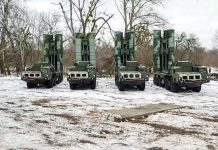One of the biggest international air force exercise, Thracian Viper 2020, is taking place in Bulgaria with a host of fighters participating to prove their might. The exercise began on September 14 with aircraft from allies Canada, Greece, and Romania flying in from their respective home bases.
Chinese PLA Soldiers Gearing-Up For Harsh ‘Ladakhi’ Winters As India-China Talks Hit The Wall
Bulgarian MiG-29s and L-39s, Canadian CF-188s – currently based in Romania under NATO’s enhanced Air Policing mission – Hellenic and US F-16s as well as Romanian F-16s and MiG-21s – will conduct Composite Air Operations executing air-to-air and air-to-ground missions, said the press release.
The release quoted the Commander of the Bulgarian Air Force, Major General Tsanko Stoykov, welcoming the allied participants “We are honoured to host this year’s edition of the integrated flying training during exercise Thracian Viper; with eleven different aircraft types we have added complexity and diversity to the exercise allowing us to perform a wide range of joint tasks in the Bulgarian airspace,” he said.
The participant forces will operate from seven military bases in Bulgaria, Greece and Romania and the overall coordination and flight management will be performed by the host nation in concert with the participants, stated the release.
Why UK’s ‘Tempest Fighter Jet Program’ Could Endanger Its Historical Ties With The United States?
“Exercise Thracian Viper 2020 will make a significant contribution to improving our capabilities to work in a coalition format,” said General Stoykov adding that it was also a demonstration of “our growing ability to ensure stability and security in Southeastern Europe, a region of strategic importance for the Alliance”.
Indian Mig-21 Vs Pakistani F-16
Notably, once again the F-16 Fighting Falcon will face Mig-21 fighters but this time at Thracian Viper 2020.
India launched a ‘surgical strike’ in Balakot last year when Indian warplanes crossed the border and dropped bombs claiming to destroy terror infrastructure in Pakistan.
This was followed by dogfight between the two sides where India claimed that it has shot down Pakistan’s F-16 jets. However, after ‘claiming’ to shoot-down the F-16 using Mig-21 Bison piloted by Wing Commander Abhinandan Varthaman, he was captured by the Pakistani Army.

The IAF’s third-generation, multirole Mig-21 is one of the widely used aircraft. It is an all-weather air defence aircraft which can hit a maximum speed of 2,230 kilometres per hour (Mach 2.1). It carries one 23mm twin-barrel cannon with four R-60 close combat missiles.
On the other hand, the US origin F-16s inducted by Pakistan Air Force (PAF) in the 1980s, are known for its agility. It has advanced characteristics, including a combat radius of 547 km, compared to 370 km of MiG-21.
However, the Indian Mig-21 Bison used by IAF are modernised versions with Spear’ radar system that allows tracking down incoming enemy aircraft at a distance of up to 57 kilometers in the front and up to 30 kilometers in the rear.
According to Tyler Rogoway of TheDrive, with the ability to carry smarter weapons, the Bison also received a very important piece of equipment from Israel, the bolt-on Elta-8222 self-protection electronic warfare pod when the Indian aircraft was upgraded with fourth-generation fighter avionics in the 1990s and 2000s.
“This was cutting edge tech in the early 2000s, but even today it is still amazingly formidable and is capable of wreaking absolute havoc on enemy radar systems—especially mechanically-scanned array fire control radars found on most 4th generation fighters,” he wrote.
Once again, the Thracian Viper 2020 will see which fighter proves to be superior. Will it be the ageing Russian origin Mig-21 or the more agile and advanced American-origin F-16?




